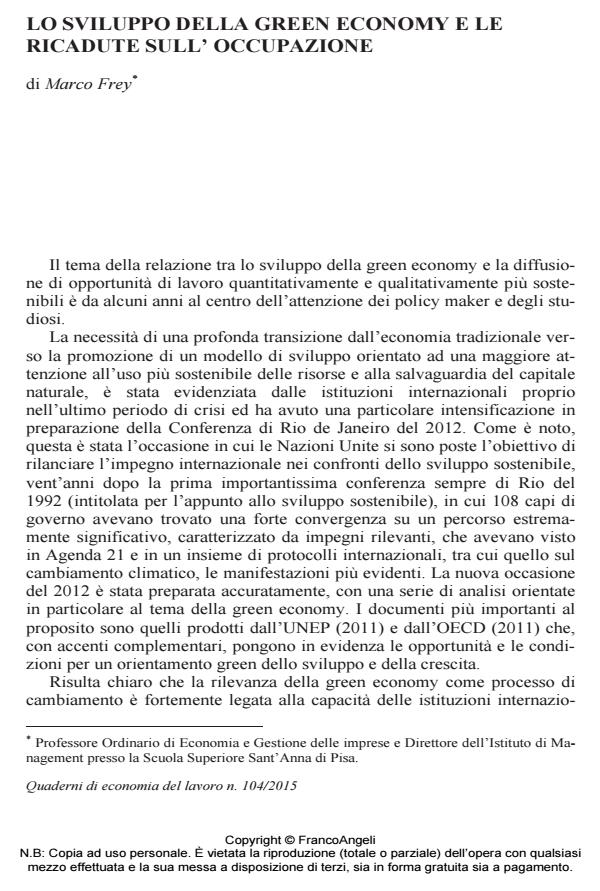Lo sviluppo della green economy e le ricadute sull’ occupazione
Titolo Rivista QUADERNI DI ECONOMIA DEL LAVORO
Autori/Curatori Marco Frey
Anno di pubblicazione 2016 Fascicolo 2015/104 Lingua Italiano
Numero pagine 34 P. 11-44 Dimensione file 413 KB
DOI 10.3280/QUA2015-104002
Il DOI è il codice a barre della proprietà intellettuale: per saperne di più
clicca qui
Qui sotto puoi vedere in anteprima la prima pagina di questo articolo.
Se questo articolo ti interessa, lo puoi acquistare (e scaricare in formato pdf) seguendo le facili indicazioni per acquistare il download credit. Acquista Download Credits per scaricare questo Articolo in formato PDF

FrancoAngeli è membro della Publishers International Linking Association, Inc (PILA)associazione indipendente e non profit per facilitare (attraverso i servizi tecnologici implementati da CrossRef.org) l’accesso degli studiosi ai contenuti digitali nelle pubblicazioni professionali e scientifiche
- Biondi V. (2013). Dallo sviluppo sostenibile alla green economy: il caso del Green Economy Network. Impresa Progetto, n. 3.
- EC (2009).Employment in Europe. DG for Employment and Social Affairs.
- EU, EC, EEO (2013). Promoting green jobs throughout the crisis: a handbook of best practices in Europe. European Employment Observatory Review.
- Ellen MacArthur Foundation (2012). Towards the Circular Economy report.
- Eurobarometer (2012). SMSes, resource efficiency and green markets. Flash, 342.
- Europe Innova (2012). “Guide to resource efficiency in manufacturing: Experiences from improving resource efficiency in manufacturing companies”.
- Federico T. (2014). Green economy e green jobs: un binomio inscindibile. Materiali di discussione. Fondazione per lo sviluppo sostenibile, Roma.
- Frey M. (2013). La green economy come nuovo modello di sviluppo. Impresa Progetto, n. 3, pp.1-18.
- Frey . (2015). La scossa profonda di Papa Francesco. Nuovi Lavori, n. 157 del 14 luglio.
- Frey M., Testa F., Iraldo F (2013). The determinants of eco innovation in green supply chains: evidence from an Italian sectoral study. R&D Management, vol. 43, n. 4, pp. 352-364.
- Frondel M., Ritter N., Schmidt C.M., Vance C. (2010). Economic impacts from the promotion of renewable energy technologies: the German experience. Energy Policy, n. 38, pp. 4048-4056.
- GHK Consulting (2007). Cambridge Econometrics and Institute for European Environmental Policy. Links Between the Environment, Economy and Jobs, Report for the European Union, DG Environment, Brussels, in: -- http://ec.europe.eu/environment/enveco/industry_employment/pdf/ghk_study_wider_links_report.pdf.
- http://ec.europe.eu/environment/enveco/industry_employment/pdf/ghk_study_wider_links_report.pdf.
- ILO, UNEP (2008). Green jobs: Towards decent work in a sustainable, low‐carbon world.
- ILO (2012). Decent work indicators: concepts and definitions. ILO manual, International Labour Office, first edition.
- ILO (2013). Sustainable development, decent work and green jobs, International Labour Conference 102nd Session, Report V, Geneva. --http://www.ilo.org/wcmsp5/groups/public/---ed_norm/---relconf/documents/meetingdocument/wcms_207370.pdf
- http://www.ilo.org/wcmsp5/groups/public/---ed_norm/---relconf/documents/meetingdocument/wcms_207370.pdf.
- ILO-UNEP (2012). Working towards sustainable development: opportunities for decent work and social inclusion in a green economy. International Labour Office. Geneva. --http://www.ilo.org/wcmsp5/groups/public/---dgreports/---dcomm/---publ/documents/publication/wcms_181836.pdf
- http://www.ilo.org/wcmsp5/groups/public/---dgreports/---dcomm/---publ/documents/publication/wcms_181836.pdf
- Iraldo F., Melis M. (2012). Green marketing. Come evitare il greenwashing comunicando al mercato il valore della sostenibilità. Il Sole 24 Ore Libri, Milano.
- Kammen D.M., Kapadia K., Fripp M. (2006). Putting renewables to work: how many jobs can the clean energy industry generate?.RAEL Report, University of California, Berkeley.
- Loorbach D., Rotmans J. (2010). The practice of transition management: Examples and lessons from four distinct cases. Futures, n. 42, pp. 237-246.
- McKinsey (2012). Mobilizing for a Resource Revolution. McKinsey Quaterly, January.
- OECD (2011). Towards Green Growth: A Summary for Policy Makers. OECD, Paris.
- OECD/Cedefop (2014). Greener Skills and Jobs. OECD Green Growth Studies, OECD Publishing. DOI: 10.1787/9789264208704-en.
- OECD (2015). Towards Green Growth? Tracking Progress. OECD Green Growth Studies, OECD Publishing, Paris.
- Perez C. (1983). Structural Change and Assimilation of New Technologies in the Economic and Social Systems. Futures, ottobre.
- Pontoni F. , Cusumano N. (2013). Green economy per una nuova e migliore occupazione. Studio dell’università Bocconi svolto per conto del Parlamento europeo.
- Porter M.E., Kramer M. (2011). Creare valore condiviso. Harvard Business Review Italia, gennaio-febbraio.
- Roland-Holst, D. (2008). Energy efficiency, innovation and job creation in California. UC Berkeley, Department of Agricultural and Resource Economics.
- Rullani E. (2010). Modernità sostenibile. Idee, filiere e servizi per uscire dalla crisi. Marsilio, Venezia.
- Schmalensee R. (2013). From “Green Growth” to sound policies: An overview. Energy Economics, n. 34, pp. S2-S6.
- Singh V. e Fehrs J. (2011). The work that goes into renewable energy. Washington D.C.: Renewable Energy Policy Project.
- Symbola AA.VV. (2010). Green Italy. Un'idea di futuro per affrontare la crisi. Quaderni di Symbola, Roma.
- Symbola AA.VV. (2012). Green Italy. L’economia verde sfida la crisi. Quaderni di Symbola, Roma.
- Symbola AA.VV. (2013). Green Italy. Rapporto 2013. Quaderni di Symbola, Roma.
- Symbola AA.VV. (2014). Green Italy. Nutrire il futuro. Quaderni di Symbola, Roma.
- Sturabotti D. (2013). Greenitaly: la green economy in Italia. Impresa Progetto, n. 3.
- UN (2012). Il futuro che vogliamo. Outocome of the RIO+20 Conference, traduzione italiana di Laura Catalani, Claudio Falasca e Toni Federico, 19 giugno.
- UNEP (2010). Green Economy Developing Countries Success Stories. UNEP, Geneva.
- UNEP (2011).Towards a Green Economy. United Nations, New York.
- US Department of Commerce (2010). Measuring the Green Economy. Economics and Statistics Administration, Washington DC.
- Victor P.A., Jackson P. (2012). A Commentary on UNEP's Green Economy Scenarios. Ecological Economics, n. 77, pp. 11-15.
- Wei M., Patadia S., Kammen D.M. (2010). Putting renewables and energy efficiency to work: how many jobs can the clean energy industry generate in the U.S.?. Energy Policy, n. 38, pp. 919-931.
- Wenjia C., Can W., Jining C., Siqiang W. (2011). Green economy and green jobs: Myth or reality? The case of China’s power generation sector. Energy, n. 36, pp. 5994-6003.
Marco Frey, Lo sviluppo della green economy e le ricadute sull’ occupazione in "QUADERNI DI ECONOMIA DEL LAVORO" 104/2015, pp 11-44, DOI: 10.3280/QUA2015-104002